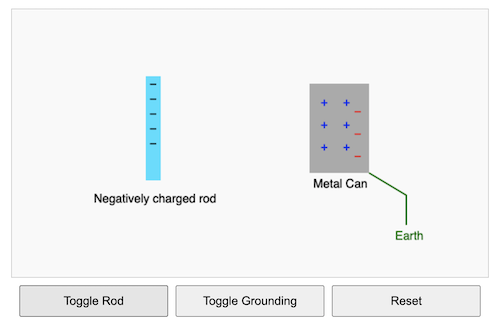Open simulation here. This was built using Claude.AI, which I notice, is better at suggesting UI features than ChatGPT or Gemini. I did not put too much effort into this as I only wanted to explain to upper sec IP students why intermolecular forces need not always be attractive, as well as to link it to the potential energy between particles in the kinetic particle model of matter.
Open in new tab 🔗Following a previous simulation on charging by induction, this simulation allows students to investigate the effects of performing the actions of bringing or removing a charged rod near a pair of conducting cans that can be placed in contact or separated-in any order they choose. Each sequence produces a distinct outcome: the cans may finish with opposite charges or both neutral. The simulation makes the invisible electron shifts clear, helping learners see exactly when charge flows between cans and when it merely redistributes inside a single conductor.

The above screenshot shows one possible state of the charges after a particular sequence of buttons are clicked. Could you figure out what is the order of buttons pressed?
In the topic of Static Electricity, charging by induction often presents a challenge for students. The process involves several invisible steps — the movement of electrons, the effect of grounding, and the lasting net charge after removing the influencing object. To bridge this gap between theory and understanding, I have created this interactive simulation to help students visualise the interactions and changes. Students can be asked to predict what will happen using various button sequences to help challenge students’ preconceptions about electric charge and behaviour during induction.

Refer to the scenario above. What will happen next if we:
a) Remove the earth wire before removing the rod, or
b) Remove the rod before removing the earth wire?
When certain materials like iron, steel, or nickel are placed near a magnet or inside a solenoid (coil of wire with current), they can become temporary magnets. This process is called induced magnetism.
You can explore this using the simulation above.
Use the Permanent Magnet
Click “Use Permanent Magnet” and drag the red-blue magnet near the grey block.
As you move it close, the arrows start to align — this shows that a magnetic field is aligning the domains, turning the material into a temporary magnet.
Try the Solenoid (Electromagnet)
Click “Use Solenoid”. This simulates a current-carrying coil.
Again, when it’s brought near the material, you’ll see the arrows align — the material becomes magnetized by the magnetic field of the solenoid.
Remove the Field
Click “Remove Magnetic Field” — the arrows scatter back to random directions. This shows that induced magnetism is temporary unless the material is a permanent magnet itself.
This interactive HTML5 simulation models the behavior of gas particles in a fixed-volume container, allowing users to explore the relationships between temperature, pressure, and particle motion. Users can adjust the temperature using a slider, which directly affects the speed of the particles based on kinetic theory. As particles collide with the container walls, they briefly turn red to visually indicate wall interactions—collisions that contribute to pressure. A real-time pressure gauge on the side rises proportionally with temperature, consistent with the ideal gas law.
Open in new tab 🔗According to the kinetic model of matter, gases consist of a large number of small particles (atoms or molecules) moving randomly and continuously in all directions. These particles have kinetic energy, which depends on temperature.
As temperature increases, the average kinetic energy of the gas particles increases. This means the particles move faster. Since pressure arises from particles colliding with the walls of the container, faster-moving particles collide more frequently and with greater force. These more energetic collisions result in a higher pressure on the container walls.
In a fixed volume, this explains why pressure is directly proportional to temperature (in kelvin), a relationship described by: $$ P \propto T $$
(if volume and number of particles are constant)
An AC generator, or alternator, is a device that converts mechanical energy into electrical energy by means of electromagnetic induction. At its core, the generator consists of a coil of wire that is made to rotate within a magnetic field. This magnetic field is usually produced by permanent magnets or electromagnets positioned so that their field lines pass through the area enclosed by the coil.
As the coil rotates, it cuts through the magnetic field lines. This motion causes the magnetic flux linkage through the coil to change over time. According to Faraday’s Law of Electromagnetic Induction, whenever there is a change in magnetic flux linkage through a circuit, an electromotive force (emf) is induced in the circuit. The faster the coil rotates or the stronger the magnetic field, the greater the rate of change of flux, and thus, the greater the induced emf.
The rotation causes the magnetic flux to vary in a sinusoidal manner, leading to an emf that also varies sinusoidally. This means the direction of the induced current reverses every half-turn, producing an alternating current (AC). The expression for the induced emf is typically given by: $\epsilon(t)=NBA\omega \sin( \omega t)$
where $N$ is the number of turns in the coil, $B$ is the magnetic flux density, $A$ is the area of the coil, $\omega$ is the angular velocity of rotation, and $t$ is time.
To extract the current from the spinning coil without tangling wires, slip rings are connected to the ends of the coil. These rotate with the coil and maintain contact with carbon brushes, which allow the generated current to flow into an external circuit.
In essence, an AC generator works by continually rotating a coil within a magnetic field, causing a periodic change in magnetic flux that induces an alternating voltage. This principle is the foundation of electricity generation in power stations around the world.